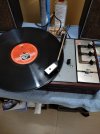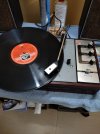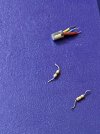I'm becoming optimistic after reading this. This means that's not an end soon.
Here I would like to ask another question. As it's a HMV thread, I think I can ask it here.
Recently I've changed all the pfs and electrolytics of one 666 model. Most of these caps were not working properly,especially electrolytes. But the problem started after this replacement. One channel (left) of this player sounds lower than the other. As I didn't change any transistor, neither wirings, I couldn't locate why this is happening. If the balance slider switch is pushed all the way to left, then only some sound comes. Otherwise, if it is kept in mid-position, only the right channels gives output loudly suppressing the left channel.
As HMV 666 diagram is available in this forum,I'm not attaching that. But I'll post few snaps of the interior tomorrow.
BTW, I've measured the voltages in b,e,c of transistors and they are showing correct values.
Any advice is highly appreciated.
Regards,
Here I would like to ask another question. As it's a HMV thread, I think I can ask it here.
Recently I've changed all the pfs and electrolytics of one 666 model. Most of these caps were not working properly,especially electrolytes. But the problem started after this replacement. One channel (left) of this player sounds lower than the other. As I didn't change any transistor, neither wirings, I couldn't locate why this is happening. If the balance slider switch is pushed all the way to left, then only some sound comes. Otherwise, if it is kept in mid-position, only the right channels gives output loudly suppressing the left channel.
As HMV 666 diagram is available in this forum,I'm not attaching that. But I'll post few snaps of the interior tomorrow.
BTW, I've measured the voltages in b,e,c of transistors and they are showing correct values.
Any advice is highly appreciated.
Regards,




